- June 1, 2021
- By neon31
- In Articles, Guest Post
- No Comment
- 0
- Tagged: Evergreen
[Opinion] Why RNG is the Best Part of Hearthstone

This article is a deep dive about RNG as a core mechanic in Hearthstone. While acknowledging that some people, especially professional players, might find RNG frustrating, watch my video to find out why RNG is actually the best part of the game. And most importantly, find out why it’s not quite as random as you might think!
Rather listen than read? Watch my video on the topic here and check out my other Hearthstone videos!
We’ve all been there. On the brink of victory with an overwhelming board of minions bearing down on our opponent. We rack our brain to remembers what “outs” are still left in their deck to save their face from shattering into a thousand pieces. We wonder why they haven’t yet conceded so we can save time and move to the next game. And then we watch them play a card that generates a random effect that sweeps away our board, snatching victory from the jaws of defeat. We ask ourselves why we play Hearthstone at all, when all the skill that got us to the cusp was negated by a wild, random effect. So why do we play Hearthstone when the random number generator, or RNG, can decide games over skill?
As frustrating as the above scenario is, Hearthstone’s RNG mechanics are actually the best and most enduring part of the game.
RNG is the mechanic that allows one card to potentially produce several different outcomes. Sometimes the outcomes are good, sometimes they are great, sometimes they are unhelpful, and sometimes they are outright bad. This randomness can be small inflections, like one or two extra attack on a Fireguard Destroyer, or completely change the game, like burning off your Neeru Fireblade with an Altar of Fire.
The concept of RNG is very polarizing, with many professional players being on record opining that RNG is killing the game. Let’s look at the pros and cons of RNG and decide for ourselves.
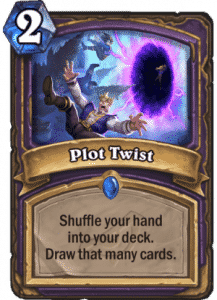
For starters, we have to acknowledge that no card game will ever be immune from RNG, if for no other reason than the fact that players are drawing cards from a randomized deck. For example, how many players tried to play Supreme Archaeology, only to find that both copies of Plot Twist were in the bottom five cards of the deck? Even without RNG effects baked into the cards, RNG will always affect the outcome of the match, and players will always be able to say that a win was lucky or unlucky because of sequencing. So, with the door open to randomness, we can move on to the cards.
Hearthstone is built to be played online, which lends itself to an RNG environment. A physical card game like Magic: The Gathering is limited by small forms of randomness, like those that could be chosen from a coin flip or dice. They can’t simply pick a random creature to summon from one of the tens of thousands of cards ever printed, and expect a player to compute this themselves. As a result, Magic is much less random than Hearthstone. The product is that games tend to be more consistent, but this comes with a significant downside: lopsided matchups. Sometimes, deck matchups in a given meta can amount to rock/paper/scissors, where one deck has almost no chance of winning versus another, which can be easily beaten by a third deck. This is perhaps more frustrating than randomness, because a match might be decided before it is even played. Of course, bad matchups can sometimes be mitigated by great gaps in skill or by the literal luck of the draw, but sometimes, the outcome is foreordained by deck choice. The randomness in Hearthstone blunts that problem by allowing for more data points that can move the needle of each match in different direction, giving any deck a chance to beat any other. The chance of winning any given game makes it more fun to play any given game, which is one notch in the column of RNG being a good thing.
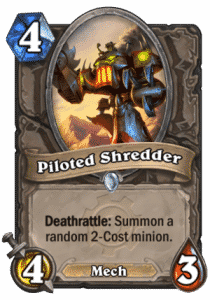
The other thing to remember about RNG is the Law of Averages. The Law of Averages supposes that future events are balanced out by past deviations; in other words, that for every bad random outcome, there will be a good random outcome that brings the average of all total outcomes to be about the same. Hence, the term “average”. The Law of Averages benefits Hearthstone not only within the outcomes within a single card, but also between cards. For outcomes of a single card, let’s examine one of the original controversial RNG cards: Piloted Shredder. This card was the subject of numerous complaints in its day, because killing the 4/3 could sometimes generate a 4/4 Millhouse Manastorm, making its removal even worse than its persistence. Then again, sometimes it could turn into a 1/1 Novice Engineer, or a 0/4 Nat Pagle, or a 0/7 Doomsayer that decimates the board of the aggressive shredder player. Over time, the average performance of the Piloted Shredder will trend toward the average stats of 2-cost minions, which is somewhere around a 2/2 or a 2/3. This was still a good deal for the shredder player at the time, but one could by no means count on getting a 2/3 from the deathrattle effect. That variance kept the card interesting – usually a great value card, but always the chance it might brick. The variance allows for either player to benefit, and keeps a win in reach for both players.
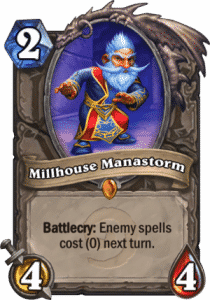
But there is also variance between cards. For example, sometimes Piloted Shredder could be killed by Lightning Storm. A player might have the less than 1% chance of dealing three damage to all seven of their opponent’s minions, and it would instantly win the game. Or, it might only deal two damage to a Piloted Shredder, leaving it in play, overloading mana crystals, and assuring the caster’s demise. If the Shredder dies, and deathrattles into Millhouse Manastorm, the result is the same. In this case, the variance in Lightning Storm is averaged out by the variance in Piloted Shredder. So, the more RNG that exists in the game, the more likelihood that the randomness in each event is averaged out by another event, and the randomness will trend to the middle, and skill will be the differentiator. But, enough randomness will be inside each match, make them unique, and give any player a chance to win any given match. That uniqueness is a special attribute of Hearthstone that makes each game fun.
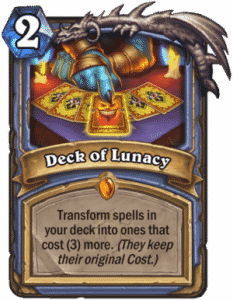
But what about when the randomness isn’t really random? Recent cards and metas have introduced scenarios that indeed have been problematic, albeit not always at the fault of the offending cards. The two most recent problem cards are Deck of Lunacy and Jandice Barov. Deck of Lunacy brought the meta to its knees at the release of Forged in the Barrens, because the pool of cards was so low. 6-mana spells are guaranteed to be transformed into Libram of Hope, and 7-mana spells will either become Survival of the Fittest, or the devastating Nagrand Slam. So, the “RNG” from Deck of Lunacy isn’t really random, because players build their decks to lean into this transformation, and then punish opponents with multiple 7-mana Nagrand Slams or multiple 6-mana monster heals and 8/8 taunts. Similarly, Jandice Barov also caused problems by not only tapping into a small-but-powerful pool of 5-mana minions, but also because it was abused with Shadowstep, giving players wide boards full of powerful minions in the middle of the game, at a bargain price. Even with as powerful as Jandice Barov is, there is still the chance of rolling into Blood Herald or other bad outcomes, but nonetheless, the abuse of playing here more than once a game, or even more than once a turn, was extremely powerful. Both of these cards will get more consistently normal as more cards are released that provide larger pools of outcomes, and better allow the Law of Averages to balance them out. But since they were a problem for the meta, they found themselves getting hit with a nerf. The nerf is not a repudiation of RNG in general, but an acknowledgement that temporarily, because of combos or small card pools, the Law of Averages might not balance out, and in such situations, Blizzard will intervene to keep the matchups mostly fair. That safety net once again allows RNG to exist for the benefit of the game, rather than the detriment.
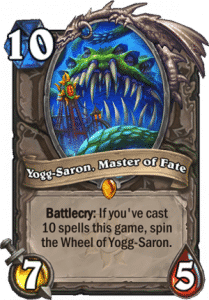
The final point to consider about RNG is the investment a deck builder makes by leaning into RNG effects. The most important card to consider in this case is Yogg-Saron, Master of Fate. This card generated intense hatred from many players, because one of the outcomes from Yogg was to cast Pyroblast repeatedly at random targets until a player died, which is the epitome of a skill-less match. However, there were a large number of mitigating factors. Firstly, this was the least-likely outcome of the six possibilities, and many of the spins of the Wheel of Fate actually made the caster’s board worse, such as the one that randomly cast spells, or the one that filled everyone’s board with random minions. On top of that, Yogg costs 10 mana, and requires the player to cast 10 spells before it activates. That is a very significant investment for a chance to randomly win the game. Many games do not last to turn 10 in the first place! So, a player who wants to rely on Yogg Saron, Master of Fate needs to have a lot of things go right before they even have a chance to get the benefits of the RNG, which even then are not assured. If a player loses to Yogg, that player should wonder what they could have done differently to win the game before Yogg became active, and not curse the Old Gods for their random mania.
For any more proof that RNG is not a tipping factor in game outcomes, look at the top professionals in the game. Notice that the same pros stay at the top of the pack for their whole careers. This tells us that skill is ultimately the deciding factor in match outcomes. Further, look at Blizzard’s recent statements about Arena matchmaking. Arena has the added RNG of decks being built with a player choosing from random cards. Yet, along with the RNG in the game itself, matches are almost always won by the player with the higher matchmaking rating. If RNG is such a scourge, how do the most skilled players still manage to win so consistently?
All in all, it is fair to say that Hearthstone is a fun, competitive game because of its random nature, not in spite of it. Any game can be won by any player, and yet the most skilled players stay at the top of the pack. No match is decided before it is played, and there’s always room for fun and hijinks from start to finish.
This article was written by Deadnight, Hearthstone vlogger and perennial legend in both Standard and Wild. You can check him out on Twitter & Youtube.
Do you want to have your work featured on Hearthstone-Decks.net? Email us at neon31HS@gmail.com, and we’ll talk! Also, feel free to join our Discord, or follow us on Twitter or Facebook. You can also support us on Patreon!
You might also be interested in...
Submit your Top 500 Legend Build, be seen by thousands of people!
Check out the Bazaar "the first free to play Hero-Builder for PC and Mac" Beginner's Guide! https://bazaar-builds.net/the-ultimate-beginners-guide-to-the-bazaar-tips-strategies-and-more/

